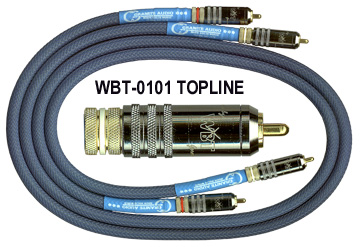Granite Audio Model #470 Silver Interconnect
| Granite Audio Model #470 Silver Interconnect |
| Constantine Soo |
| 30 December 2000 |
 Specifications
Specifications
Pricing: 22-gauge, 99.9999% pure silver, Slow-Drawn Pure Silver (SDPS), continuous-cast crystal formation, 100% optimized shielding with both continuous foil and silver braid
RCAs: hard-gold over silver, over copper.
(Now using WBT-0101 Topline RCA)
Price: $600/0.5 meter pair, $950/meter pair, $1,075/1.5 meter pair.
Custom length & termination: $450 per meter pair plus $300 RCA or XLR connectors.
Granite Audio
824 South Mill Avenue, #88
Tempe, AZ 85281
Phone: 480-829-8374
Fax: 480-968-0159
Web: www.graniteaudio.com
Email: info@graniteaudio.com
This is a review of a one-meter pair of Granite Audio’s model #470 silver interconnects. The review took place before the WBT-0101 Topline RCA plugs became available.
An audio system is only as good as its weakest link, be it a turntable, CD player, preamp, power amp, speakers, etc. If you have invested substantially in your components for the sake of a better sound, and you are again thinking about upgrading possibly spending another several thousands of dollars on a new piece, maybe you should stop to consider the alternative of how to maximize the performance of your existing gear.
The effect and benefit reaped from upgrading to the #470 will likely be dramatic and appreciated in a top-notch system.
While changing or upgrading the components can improve the presentation of one’s system, using the model #470 may not bring about a nearly as pleasant an experience in some instances. In some systems, the #470 might expose more of the system’s intrinsic limitations and colorations, where before, the various shortfalls were less noticeable.
About the Interconnect
According to Granite Audio, the model #470 interconnects are made from the process of slow drawing, using 99.9999% pure silver, resulting in the formation of a single continuous crystal. From my numerous e-mails with company president, Don Hoglund (don@graniteaudio.com), I have learned that this continuous-cast, slow-drawn technique differs from the process used by most cable makers. With normal manufacturing techniques, in any given meter, anywhere from 40 to several thousand crystals are formed. These crystals are created with microscopic gaps between each crystal boundary, resulting in greater resistance, and thus, signal loss.
After the cable is drawn, it is wrapped in an optimized shield with both continuous foil and silver braid. The connection is completed by a lockable 9mm RCA connector, which has a hard-gold finish over silver, on top of copper. I especially appreciate the lockable connector, in that it can be loosened for disconnection and tightened for stabilization. Once upon a time, I used the Monster Cable’s “turbine” connectors, and the death grip they imposed almost tore the RCA jacks off my equipment. Scary.
Evaluation
At $950 per meter per pair, the model #470s are certainly not cheap; but in my experience the improvements that they bring to a top notch system are comparable to the performance gained by swapping other components of high caliber.
My system is modest by state-of-the-art audiophile standards, and I suspect that the improvements I experienced will be maximized in a system capable of the highest sonic realism. The strength of the model #470 is significant in minimizing signal loss, and preserves a high degree of signal integrity.
The contribution of these interconnects surprised me, and helped me realize the long-hidden potential of my system. Throughout the years, I’ve sold countless components in the pursuit of higher sonic realism, and I suspect that many of you readers have had the same experience. As I look back, I think to myself—maybe I shouldn’t have sold my Sonic Frontiers SFL-2 or my Krell KSL-2, before that. Perhaps it was a foolish mistake to ditch my Audio Research D-76a—and the list goes on.
Right out of the wrapper, the model #470’s imaging was on the level of my Kimber KCAGs; however, my KCAGs were smoother in texture. These initial impressions were encouraging. For the following week, I ran the model #470s from my hi-fi VCR’s audio outputs to the inputs of my MiniDisc recorder.
After about the 100th hour of burn-in (as recommended by Don Hoglund), the first thing I noticed was how much more information I was hearing from my CDs through my Klipschorn speakers. Now, the presentation carries distinctive timbres from all instruments in the recordings, rendering the sound so lifelike that each reproduced note of music is revealed.
Vocals are relayed with an intoxicating sense of presence. For example, Kathleen Battle’s rendition of Johann Strauss’ Voices of Spring (Deutsche Grammophon 419 616-2) has a natural human warmth and humidity from her vocal chord. Complex orchestral passages now are being reproduced with the magnificence and glory they deserve, such is the case with the remastered Original-Image Bit-Processing version of Richard Strauss’ Also Sprach Zarathustra (Deutsche Grammophon D-134748). And Tiger Okoshi’s jazz performances of On Green Dolphin Street (JVC 2039-2) are energetic, and rife with finesse and sparkle.
In the area of analytical capability, the model #470 is a blessing. Before, the presentation was homogeneous, so much so, that sounds and instruments within the soundstage were somewhat chaotic. This chaos has been reduced significantly and the localization of instruments and voices can easily be discerned with different tonal shadings. The respective soundstages on different recordings are realistic, and can be breathtaking.
Both macro- and micro-dynamic contrasts are presented vividly, and are now in synchronization with the rhythm and pace of the musical beat. The unbridled dynamics unleashed from recordings through my Klipschorns are akin to what I hear at a live musical event. I shall expand on the Klipschorn’s dynamic virtues at another point in time.
Only one problem developed during my evaluation of the model #470, which was an elevated background noise level produced through my Klipschorns. Considering the reduced impedance of these fine cables, and the very high sensitivity of my Klipschorns, I thought this was to be expected. But, Hoglund suggested that the interconnects’ direction of flow be reversed between my Wadia and Music Reference power amp, so that the internal grounding would be removed. He was right, and the noise abated—but so much for my 100-hour burn-in ritual. So, this is something to keep in mind when installing the interconnects.
Conclusion
Audio buffs (like us) know well the importance of using high quality interconnects and wiring. But this aspect has never been prominent to me—until recently. I have finally learned not to underestimate the role that a good pair of interconnects can play in improving the performance of one’s system.
A good set of interconnects should be impartial to the signal it transmits, and I believe this to be true of the Granite Audio model #470s. These interconnects can be addictive, and make one wonder about the sonic potential of adding more silver to one’s system—such as speaker cables. What will happen to the already very clear and 3-dimensional presentation? That’s a BIG question mark with a big price tag attached, and its answer is often acquired by those of us with more capable financial means—the lucky ones. Perhaps my reviewer’s status will afford me that luxury in the near future.
Without the model #470, I could not have experienced the excellence of the components and CDs that I currently own. It makes my audio system sing, and enables my components to sound much more authentic and musical. I bought my review pair, and I bought a second pair several months later to link my Krell preamp to the Monarchy Audio power amp. Never has my system sounded better.
![]()
Don’t forget to bookmark us! (CTRL-D)
Stereo Times Masthead
Publisher/Founder
Clement Perry
Editor
Dave Thomas
Senior Editors
Frank Alles, Mike Girardi, Russell Lichter, Terry London, Moreno Mitchell, Paul Szabady, Bill Wells, Mike Wright, and Stephen Yan,
Current Contributors
David Abramson, Tim Barrall, Dave Allison, Ron Cook, Lewis Dardick, John Hoffman, Dan Secula, Don Shaulis, Greg Simmons, Eric Teh, Greg Voth, Richard Willie, Ed Van Winkle, Rob Dockery, Richard Doran, and Daveed Turek
Site Management Clement Perry
Ad Designer: Martin Perry





Be the first to comment on: Granite Audio Model #470 Silver Interconnect